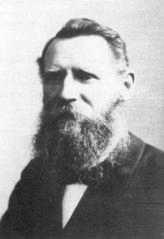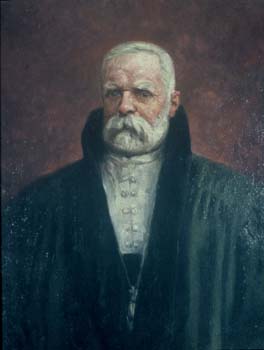<Back to Index>
- Physicist Woldemar Voigt, 1850
- Writer Giovanni Verga, 1840
- Reich Minister of War General Field Marshal Werner Eduard Fritz von Blomberg, 1878
PAGE SPONSOR


Woldemar Voigt (2 September 1850 – 13 December 1919) was a German physicist, who taught at the Georg August University of Göttingen. Voigt eventually went on to head the Mathematical Physics Department at Göttingen and was succeeded in 1914 by Peter Debye, who took charge of the theoretical department of the Physical Institute. In 1921, Debye was succeeded by Max Born.
Voigt was born in Leipzig, and died in Göttingen. He was a student of Franz Ernst Neumann. He worked on crystal physics, thermodynamics and electro - optics. His main work was the Lehrbuch der Kristallphysik (textbook on crystal physics), first published in 1910. He discovered the Voigt effect in 1898. The word tensor in its current meaning was introduced by him in 1899. Voigt profile and Voigt notation are named after him. He was also an amateur musician and became known as a Bach expert.
In 1887 Voigt formulated a form of the Lorentz transformation between a rest frame of reference and a frame moving with speed v in the x direction. However, as Voigt himself declared, the transformation was aimed for a specific problem and did not carry with it the ideas of a general coordinate transformation, as is the case in relativity theory. In modern notation Voigt's transformation was
where  . If the right - hand sides of his equations are multiplied by γ they are the modern
Lorentz transformation. Hermann Minkowski said
in 1908 that the transformations which play the main role in the
principle of relativity were first examined by Voigt in 1887. Also Hendrik Lorentz (1909)
is on record as saying he could have taken these transformations into
his theory of electrodynamics, if only he had known of them, rather
than developing his own. It is interesting then to examine the
consequences of these transformations from this point of view. Lorentz
might then have seen that the transformation introduced relativity of simultaneity, and also time dilation.
However, the magnitude of the dilation was greater than the now
accepted value in the Lorentz transformations. Moving clocks, obeying
Voigt's time transformation, indicate an elapsed time ΔtVoigt = γ − 2Δt = γ − 1ΔtLorentz, while stationary clocks indicate an elapsed time Δt.
. If the right - hand sides of his equations are multiplied by γ they are the modern
Lorentz transformation. Hermann Minkowski said
in 1908 that the transformations which play the main role in the
principle of relativity were first examined by Voigt in 1887. Also Hendrik Lorentz (1909)
is on record as saying he could have taken these transformations into
his theory of electrodynamics, if only he had known of them, rather
than developing his own. It is interesting then to examine the
consequences of these transformations from this point of view. Lorentz
might then have seen that the transformation introduced relativity of simultaneity, and also time dilation.
However, the magnitude of the dilation was greater than the now
accepted value in the Lorentz transformations. Moving clocks, obeying
Voigt's time transformation, indicate an elapsed time ΔtVoigt = γ − 2Δt = γ − 1ΔtLorentz, while stationary clocks indicate an elapsed time Δt.
Lorentz did not adopt this transformation as he found in 1904 that only the Lorentz contraction corresponds to the principle of relativity. Since Voigt's transformation preserves the speed of light in all frames, the Michelson - Morley experiment and the Kennedy - Thorndike experiment can not distinguish between the two transformations. The crucial question is the issue of time dilation. The experimental measurement of time dilation by Ives and Stillwell (1938) and others settled the issue in favor of the Lorentz transformation.



